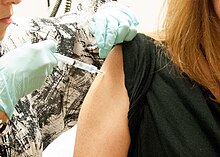
Back لقاح الإيبولا Arabic Ebola-Impfstoff German Vacunas contra el Ébola Spanish Vaccin contre le virus Ebola French Vaksin ebola ID Vaksin ebola Malay Ebola aşısı Turkish Vắc-xin Ebola Vietnamese
 Candidate Ebola vaccine being given | |
| Vaccine description | |
|---|---|
| Target | Ebola virus |
| Vaccine type | Viral vector |
| Clinical data | |
| Trade names | Ervebo, Zabdeno, Mvabea |
| ATC code | |
| Legal status | |
| Legal status | |
| Identifiers | |
| CAS Number | |
Ebola vaccines are vaccines either approved or in development to prevent Ebola. As of 2022, there are only vaccines against the Zaire ebolavirus. The first vaccine to be approved in the United States was rVSV-ZEBOV in December 2019.[9][10] It had been used extensively in the Kivu Ebola epidemic under a compassionate use protocol.[11] During the early 21st century, several vaccine candidates displayed efficacy to protect nonhuman primates (usually macaques) against lethal infection.[12][13][14]
Vaccines include replication-deficient adenovirus vectors, replication-competent vesicular stomatitis (VSV) and human parainfluenza (HPIV-3) vectors, and virus-like nanoparticle preparations. Conventional trials to study efficacy by exposure of humans to the pathogen after immunization are not ethical in this case. For such situations, the US Food and Drug Administration (FDA) has established the "animal efficacy rule" allowing licensure to be approved on the basis of animal model studies that replicate human disease, combined with evidence of safety and a potentially potent immune response (antibodies in the blood) from humans given the vaccine. Clinical trials involve the administration of the vaccine to healthy human subjects to evaluate the immune response, identify any side effects and determine the appropriate dosage.[15]
- ^ "Ervebo (zaire ebolavirus- strain kikwit-95 envelope glycoprotein injection, solution". DailyMed. 13 December 2022. Archived from the original on 5 March 2023. Retrieved 4 March 2023.
- ^ Cite error: The named reference
FDA Ervebowas invoked but never defined (see the help page). - ^ Cite error: The named reference
Ervebo EPARwas invoked but never defined (see the help page). - ^ Cite error: The named reference
Ervebo PIwas invoked but never defined (see the help page). - ^ Cite error: The named reference
Zabdeno EPARwas invoked but never defined (see the help page). - ^ "Zabdeno Product information". Union Register of medicinal products. Archived from the original on 5 March 2023. Retrieved 3 March 2023.
- ^ Cite error: The named reference
Mvabea EPARwas invoked but never defined (see the help page). - ^ "Mvabea Product information". Union Register of medicinal products. Archived from the original on 5 March 2023. Retrieved 3 March 2023.
- ^ "First FDA-approved vaccine for the prevention of Ebola virus disease, marking a critical milestone in public health preparedness and response". U.S. Food and Drug Administration (FDA) (Press release). 19 December 2019. Archived from the original on 20 December 2019. Retrieved 19 December 2019.
 This article incorporates text from this source, which is in the public domain.
This article incorporates text from this source, which is in the public domain.
- ^ McKee S (23 December 2019). "US approves Merck's Ebola vaccine". PharmaTimes Online. Surrey, England: PharmaTimes Media Limited. Archived from the original on 25 January 2021. Retrieved 24 December 2019.
- ^ Beth Mole (16 April 2019). "As Ebola outbreak rages, vaccine is 97.5% effective, protecting over 90K people". Ars Technica. Archived from the original on 19 February 2021. Retrieved 5 July 2019.
- ^ Hoenen T, Groseth A, Feldmann H (July 2012). "Current ebola vaccines". Expert Opinion on Biological Therapy. 12 (7): 859–72. doi:10.1517/14712598.2012.685152. PMC 3422127. PMID 22559078.
- ^ Peterson AT, Bauer JT, Mills JN (January 2004). "Ecologic and geographic distribution of filovirus disease". Emerging Infectious Diseases. 10 (1): 40–47. doi:10.3201/eid1001.030125. PMC 3322747. PMID 15078595.
- ^ Fausther-Bovendo H, Mulangu S, Sullivan NJ (June 2012). "Ebolavirus vaccines for humans and apes". Current Opinion in Virology. 2 (3): 324–29. doi:10.1016/j.coviro.2012.04.003. PMC 3397659. PMID 22560007.
- ^ Pavot V (December 2016). "Ebola virus vaccines: Where do we stand?". Clinical Immunology. 173: 44–49. doi:10.1016/j.clim.2016.10.016. PMID 27910805.